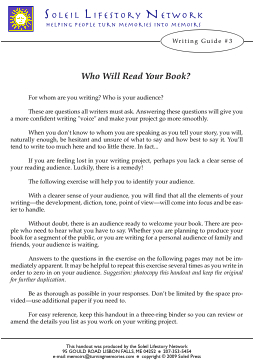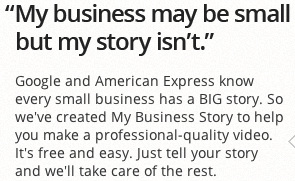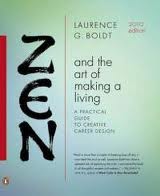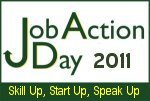These goodies from practitioners have caught my eye recently:
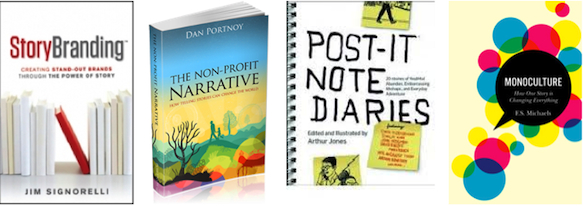
Scroll down to see more about these story-related books.
In Stories Matter: How to Power Up Your Activism, Thaler Pekar shares personal stories from her own history to illustrate the power of stories in activism. She noted to me that she doesn’t often share stories so personal. They powerfully illustrate the article’s premise.
Thaler also also offers a piece in her blog that frames Occupy Wall Street as a sensemaking exercise: Making Sense of Occupy Wall Street. Her final paragraph is striking:
From action will come audience, and from audience will come message. Out of what seems like chaos, insight will occur. Occupy Wall Street is making sense out of complex experiences.
On StoryFountain, Richard House has launched a series, “From Storytelling to Narrativity,” in which he will “profile the opinion-formation process, explain the ‘horizontal axis’ of Narrativity, present a theoretical basis for understating the persuasive power of Storytelling, and show how four of the great public issues of our time are being presented by our leaders.”
The horizontal axis of storytelling? It is …
… all about conscious intention — how we wish to influence people; what we want them to do. This is the axis of Narrativity. This means the way a story is deliberately presented by the teller, and the way it’s understood subjectively by the audience. Narrativity is, if you like, the “public affairs” branch of Storytelling.
The vertical axis is storytelling:
Storytelling, which can delve down through myth to the unconscious to mankind’s social and spiritual origins, forms the vertical axis of our quest. But understanding the origins and psychological power of the stories we tell people and how they work, is only part of the story.
Four story-related books (disclaimer: I haven’t read them):
In StoryBranding: Creating Stand-Out Brands Through the Power of Story, author Jim Signorelli (according to the book’s publisher) “shows how the principles of story can give brands more meaning In six clear steps, Jim Signorelli shows marketers how to develop brand-planning documents that have much more punch than traditional creative briefs. Signorelli includes sample ‘I AM Statements’ and ‘StoryBriefs’ that dramatically illustrate how his StoryBranding approach can develop brands that customers will insist on buying relative to competitive alternatives.”
The upcoming book, The Non-Profit Narrative: How Telling Stories Can Change the World, from Portnoy Media Group chief storyteller Dan Portnoy, shows how non-profits thrive by telling great stories. You can read a preview chapter of the book.
The premise of Post-It Note Diaries: 20 stories of youthful abandon, embarrassing mishaps, and everyday adventure is best understood in the words of editor and illustrator Arthur Jones (note a preview chapter is also offered):
The origin of Post-it Note Diaries starts a few years ago when I was working at painfully boring office. I was hired to design banner ads and supermarket coupons but the company was over-staffed so I spent most of my time pretending to be busy. To fend off the boredom, I started covertly writing stories in Microsoft Excel documents and illustrating them on Post-its. I found 3 inch yellow pads of Post-its to be perfect little sketchbooks and I could swipe hundreds of them at a time from the supply closet without anyone noticing. Eventually I started reading these work stories in public — at bars, bookstores and art galleries. To accompany my performances I projected a slideshow of my Post-it Note drawings behind me. It was a little like narrating a comic one panel at a time or presenting a hand drawn lecture. Months later my friend Starlee Kine and I took that format and expanded it into the Post-it Note Reading Series. Each show was an experiment, where both established authors and non-writers could present stories over a backdrop of my Post-it drawings. Post-it Note Diaries is an extension of the Reading Series. It features some stories that are old favorites and some new work by some of my favorite writers and performers. Admittedly it’s a book that’s hard to explain– part non fiction anthology, part graphic memior — but it’s easy to figure out once you open it. To best understand exactly what Post-it Note Diaries is, read the first chapter by humorist John Hodgman and everything should start to make sense. — Arthur Jones editor & illustrator
Monoculture: How Our Era’s Dominant Story Shapes Our Lives, is, according to reviewer Maria Popova, “a provocative investigation of the dominant story of our time and how it’s shaping six key areas of our lives: our work, our relationships with others and the natural world, our education, our physical and mental health, our communities, and our creativity.” A further explanation from the author:
The governing pattern a culture obeys is a master story — one narrative in society that takes over the others, shrinking diversity and forming a monoculture. When you’re inside a master story at a particular time in history, you tend to accept its definition of reality. You unconsciously believe and act on certain things, and disbelieve and fail to act on other things. That’s the power of the monoculture; it’s able to direct us without us knowing too much about it.” ~ F. S. Michaels
